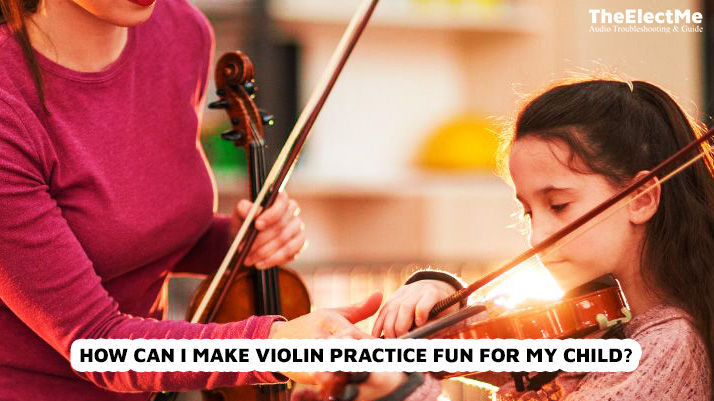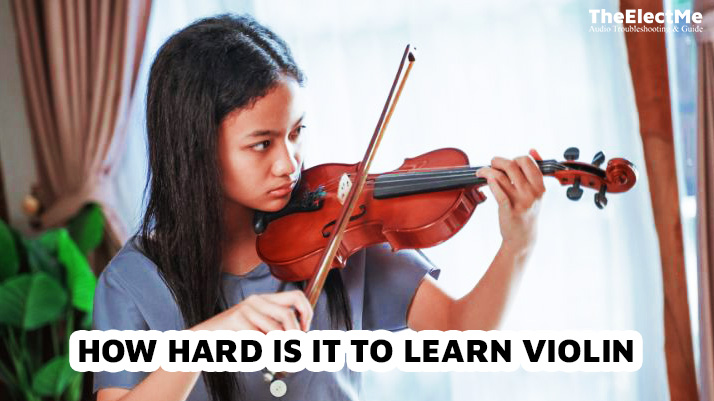According to recent studies, 50% of children who start learning an instrument will quit within the first year. As a parent, it can be disheartening to see your child lose interest in something they were once excited about. Lack of interest in practice is a common problem among young violinists.

How can I make violin practice fun for my child? This is a million-dollar question asked by many parents. You can make violin practice enjoyable for your child with the right approach and techniques. Read on to learn more about motivating your child to practice the violin.
Let’s begin by discussing the approach to childhood learning.
Understanding Your Child’s Learning Style
As a parent, it’s essential to recognize your child’s learning style. There are three main learning styles: visual, auditory, and kinesthetic. Each child has a dominant learning style that helps them learn better and retain information effectively.
Visual learners
Visual learners grasp concepts through visual aids such as pictures, diagrams, or videos. They tend to have a strong imagination and can quickly memorize images rather than words.
For these children, incorporating visuals into violin practice can make it more enjoyable. Use flashcards or fingerboard stickers to help your child recall where to place their fingers.
Auditory learners
Auditory learners learn best through listening and speaking. They have a strong sense of hearing and can easily remember information through sound. These children may enjoy listening to music while practicing the violin or cello or hearing you play a piece before they try it themselves.
Kinesthetic learners
Kinesthetic learners learn best by doing and experiencing things physically. They can naturally move their body and may struggle with sitting still for long periods. To make practice fun for kinesthetic learners, incorporate more physical activities.
How Can I Make Violin Practice Fun For My Child? 4 Methods
To make violin practice enjoyable for your child, try these four methods:
Using Technology to Make Practice More Interactive
With technological advancements, there are various ways to make violin practice more interactive and enjoyable for children. Here are some methods that involve leveraging technology:
- Virtual Reality Games for Music Learning: Introducing VR games for music learning provides children with a unique and immersive experience. These games simulate various musical settings, offering a fun, educational way to practice violin skills.
- Apps for Practicing Sight-Reading and Ear Training: Utilizing apps focusing on sight-reading and ear training can enhance a child’s musical abilities. These apps often gamify the learning process, making it more engaging and effective for young learners.

Parents can offer kids innovative and fun ways to interact with music by using technology in violin practice.
Setting Realistic Goals and Celebrating Achievements
Setting realistic goals and recognizing achievements are vital to making violin practice enjoyable and rewarding for kids. By dividing practice into manageable tasks and celebrating progress, parents can motivate kids to learn the violin. Here are strategies to achieve this:
- Breaking Down Practice Sessions into Smaller, Achievable Tasks: Divide practice sessions into smaller segments focusing on specific techniques, pieces, or exercises. This approach helps prevent overwhelm and allows the child to focus on mastering one aspect at a time, leading to steady progress.
- Celebrating Progress and Accomplishments with Tangible Rewards: Recognize and celebrate your child’s milestones and achievements during practice sessions. Consider rewarding them with tangible incentives such as stickers, small treats, or extra playtime to reach practice goals or show improvement.
Parents foster a supportive environment that builds pride and success in music by setting realistic goals and celebrating their child’s achievements.
Incorporating Playtime into Practice Sessions
Incorporating play into violin practice makes learning more enjoyable, boosting engagement and skill development. By using play, such as role-playing and fun challenges, parents can create a dynamic environment for children.
Here are strategies to incorporate playtime into violin practice sessions:
- Role-Playing Exercises with the Violin as a Prop: Encourage your child to engage in role-playing exercises where they use the violin as a prop to act out musical scenarios. For example, they can pretend to be a famous violinist performing on stage or a composer creating a new piece. This creative approach makes practice fun and fosters imaginative thinking and musical expression.
- Creating Fun Challenges and Rewards for Completing Practice Goals: Introduce fun challenges in practice, like playing a piece in a new style or mastering an onerous section. Reward your child with stickers, treats, or extra playtime for completing practice goals. Challenges and rewards make violin practice exciting and motivating, making it a rewarding experience.
By adding play, parents can grow their child’s love for music and encourage creativity, motivation, and skill development. The violin has many interesting facts that encourage children to practice. 7 facts about violin add curiosity to the reader.
Encouraging Creativity During Practice
Fostering creativity in music practice boosts a child’s musical growth and artistic expression. Parents can foster creativity and a deeper love for music by writing music and exploring genres with their children. Here are strategies to encourage creativity during violin practice:
- Allowing Children to Compose Their Music Pieces: Encourage your child to explore melodies, rhythms, and harmonies on the violin and create their music. This hands-on approach boosts their creativity, creating a sense of ownership and success in their musical journey.
- Exploring Different Genres and Styles of Music: Introduce your child to various musical genres and styles beyond classical music. Exploring jazz, folk, or world music helps children find new sounds and get inspired by diverse cultures.
By encouraging creativity through activities, parents support their child’s musical growth and make practice an exciting and enriching experience.
Final Thoughts – How Can I Make Violin Practice Fun For My Child?
In conclusion, fostering a positive and engaging environment for violin practice is vital to nurturing a child’s musical journey. Adding creativity through activities enriches their knowledge and love for music.
Patience is crucial in making practice fun for kids. Just like learning any new skill, mastering the violin takes time and patience. As a parent, try to maintain an optimistic attitude throughout practice sessions and encourage your child when they face challenges.
With these strategies in mind, parents can make violin practice a fun and rewarding experience for their child.



